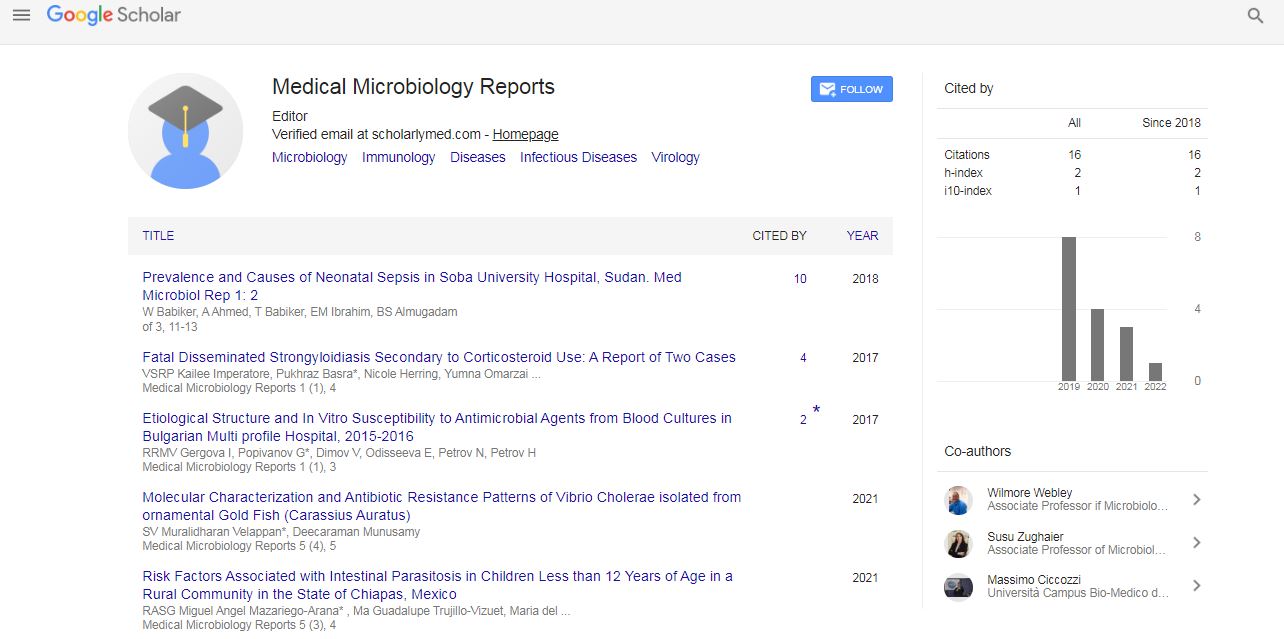Commentary, Med Microbiol Rep Vol: 7 Issue: 2
Techniques and Methods in Recognition of Invisible Threats from Infectious Diseases
Nejla Liang*
Department of Medicine, Mahidol University, Bangkok, Thailand
*Corresponding Author: Nejla Liang
Department of Medicine, Mahidol University, Bangkok, Thailand
E-mail: nejlian@mahidol.ac.th
Received date: 22 May, 2023, Manuscript No. MMR-23-107442;
Editor assigned date: 25 May, 2023, PreQC No. MMR-23-107442 (PQ);
Reviewed date: 08 June, 2023, QC No. MMR-23-107442;
Revised date: 15 June, 2023, Manuscript No. MMR-23-107442 (R);
Published date: 22 June, 2023, DOI: 10.4172/mmr.1000338
Citation: Liang N (2023) Techniques and methods in Recognition of Invisible Threats from Infectious Diseases. Med Microbiol Rep 7:2
Description
Infectious diseases have frequently concealing in accessibility and constituting invisible dangers. These diseases, caused by a wide array of pathogenic microorganisms, can rapidly spread through populations, resulting in illness, death, and societal disruptions.
The microscopic size of the microorganisms that cause infectious diseases is the foundation of their invisible nature. Bacteria, viruses, fungi, and parasites are frequently too microscopic to be visible to the normal eye, making their presence difficult to detect without specialized tools and techniques. These pathogens can be transmitted through various means, including person-to-person contact, contaminated food and water, insect bites and even the air we breathe. It is essential to develop techniques for the prompt detection and management because of its tendency to spread silently throughout communities while remaining undetected.
One of the primary challenges in recognizing invisible threats from infectious diseases lies in the nonspecific symptoms they often exhibit, particularly in the early stages of infection. Many infectious diseases initially present with mild flu-like symptoms, which can easily be mistaken for other common ailments. This delayed recognition and diagnosis can result in missed opportunities for prompt treatment and effective containment measures, leading to further transmission and increased morbidity and mortality.
The advancements in laboratory diagnostics have also played a pivotal role in recognizing and characterizing invisible threats from infectious diseases. Molecular diagnostic techniques, such as Polymerase Chain Reaction (PCR) and next-generation sequencing, have revolutionized the field by providing highly sensitive and specific tools for pathogen detection and identification. These techniques can rapidly identify the presence of specific pathogens in clinical samples, allowing for timely and accurate diagnosis.
Additionally, improvements in point-of-care testing have enabled faster and more accessible diagnostics, particularly in resource-limited settings. Rapid diagnostic tests for diseases like malaria, tuberculosis and Human Immunodeficiency Virus (HIV) have greatly improved early detection and treatment initiation, even in remote areas where laboratory infrastructure may be limited. Such technological innovations contribute to a more efficient response to infectious disease threats and reduce the burden on healthcare systems.
Public awareness and education campaigns are essential components of recognizing invisible threats from infectious diseases. By providing accurate and up-to-date information about disease symptoms, preventive measures and the importance of seeking early medical attention, these campaigns empower individuals to recognize the warning signs and take appropriate action. Community engagement and education foster a sense of collective responsibility, encouraging people to adopt healthy behaviors and actively participate in disease surveillance efforts.
International collaboration is important in recognizing and responding to invisible threats from infectious diseases, particularly those with pandemic potential. Global health organizations, such as the World Health Organization (WHO), facilitate coordination, knowledge sharing and resource mobilization to address emerging infectious disease threats. Collaborative efforts enhance surveillance capabilities, promote analysis and development, and strengthen healthcare systems, ensuring a robust response to global health emergencies.
As people navigate the challenges of recognizing invisible threats from infectious diseases, it is essential to prioritize preparedness and invest in innovations. Investments in public health infrastructure, including robust healthcare systems, laboratory networks and a skilled workforce, are necessary to secure effective responses and protect populations from unseen dangers.
Recognizing invisible threats from infectious diseases is a multifaceted endeavor that requires vigilance, scientific advancements and coordinated efforts. By leveraging technological innovations, strengthening surveillance systems, raising public awareness and fostering international collaboration, people can enhance the ability to identify and mitigate these invisible threats.
 Spanish
Spanish  Chinese
Chinese  Russian
Russian  German
German  French
French  Japanese
Japanese  Portuguese
Portuguese  Hindi
Hindi 
